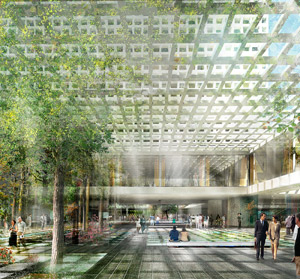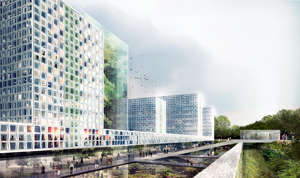 |
 |
 |
 |
 |
 |
| |
 |
|
 |
 |
 |
  |
  |
 |
 |
 |
 |
|
|
 |
|
 |
 |
 |
BUILDING |
 |
|
 |
|
 |
 |
 |
| |
 |
| 
 |
International Criminal Court
|
|
 |
 |
 |
 |
DESIGNER |
 |
|
|
 |
|
 |
 |
 |
| |
 |
|
 |
 |
 |
 |
DESCRIPTION |
 |
|
|
 |
|
 |
 |
 |
|
|
 |
 When designing the new permanent premises of the International Criminal Court, the point of departure was to communicate trust, hope and – most importantly – faith in justice and fairness. The building should have the courage to be an ambassador for the credibility of the ICC. The project and its architecture should be impressive and grandiose but should always relate to humans and the human scale. It is important that a formal institution like the ICC does not constitute barriers for people. On the contrary, it must express the very essence of democratic architecture. When designing the new permanent premises of the International Criminal Court, the point of departure was to communicate trust, hope and – most importantly – faith in justice and fairness. The building should have the courage to be an ambassador for the credibility of the ICC. The project and its architecture should be impressive and grandiose but should always relate to humans and the human scale. It is important that a formal institution like the ICC does not constitute barriers for people. On the contrary, it must express the very essence of democratic architecture.
 Located close to the North Sea the site is placed between the nature and the city. Connecting the dune landscape with the edge of the city has a striking potential. By designing a compact building with a small footprint, the landscape is returned to the city so that the open spaces, the sky and the horizon become an integrated part of the architectural composition. Located close to the North Sea the site is placed between the nature and the city. Connecting the dune landscape with the edge of the city has a striking potential. By designing a compact building with a small footprint, the landscape is returned to the city so that the open spaces, the sky and the horizon become an integrated part of the architectural composition.
Through the lightness and simplicity in the architectural design, the values of openness and transparency are communicated. The building is designed as a sculptural abstraction – a composition of 6 volumes, firmly anchored to the site and rising from the surrounding dune landscape.
The tallest of the volumes is the Court Tower that rises up as a green element. The architectural idea is to continue the cultivated parterre gardens from the ground floor level as a cladding on the Court Tower. Historically, gardens have always existed as part of all cultures and all religions. With flowers and plants from each of the 110 member countries, the parterre garden rises up as a symbol of unity, regardless of nationality and culture. The remaining volumes, the office towers, are draped in a tapestry grid, almost like embroidery. The office façade grid is designed with angle and cut-outs, which allows the light to reflect differently in an almost playful way.
The overall architectural expression becomes an abstract and informal sculpture – a backdrop for communicating the values of the ICC. |
|
 |
 |
 |
 |
 |
 |
 |
VIDEO |
 |
|
|
 |
|
 |
 |
 |
| |
 |
|
 |
 |
 |
 |
LOCATION |
 |
|
|
 |
|
 |
 |
 |

|
 |

|
Continent |
|
 |
|
Nation |
|
 |
|
Region |
|
 |
|
Region |
|
 |
|
Town |
|
 |
|
Place |
|
 |
|
Address |
|
 |
|
|
|
 |
|
 |
 |
 |
 |
MAP |
 |
|
|
 |
|
 |
 |
 |
| |
 |
|
 |
 |
 |
 |
|
TYPOLOGY |
 |
|
|
 |
|
 |
 |
 |
|
|
 |
ARCHITECTURE | Public buildings
Justice buildings
| |
 |
 |
 |
 |
CHRONOLOGY |
 |
|
|
 |
|
 |
 |
 |
Project |
 |
|
 |
| 
 |
2008 - 2010
project winner of limited competiton
|
|
Realisation |
 |
|
 |
| 
 |
2012 - 2015 |
|
 |
 |
 |
 |
BIBILIOGRAPHIC REFERENCES |
 |
|
|
 |
|
 |
 |
 |
|
 |
| "Give hope" in schmidt hammer lassen architects (ed.), Give more, Aedes, Berlin 2012, pp. 20-27 |
|
 |
 |
 |
 |
 |
 |
 |
CLIENT |
 |
|
|
 |
|
 |
 |
 |
| |
 |
| The International Criminal Court |
|
 |
 |
 |
 |
AMOUNT |
 |
|
|
 |
|
 |
 |
 |
| |
 |
|
 |
 |
 |
 |
DIMENSIONAL
DATA |
 |
|
|
 |
|
 |
 |
 |
| Surface |
 |
|
 |
|
| Number |
 |
|
 |
|
 |
 |
 |
 |
LANDSCAPE DESIGN |
 |
|
|
 |
|
 |
 |
 |
| |
 |
|
 |
 |
 |
 |
STAFF |
 |
|
|
 |
|
 |
 |
 |
|
 |
|
Engineering |
 |
Royal Haskoning
Esbensen Consulting Engineers |
|
Art intervention |
 |
| Bosch & Fjord in collaboration with schmidt hammer lassen architects |
|
 |
 |
 |
 |
CREDITS |
 |
|
|
 |
|
 |
 |
 |
| |
 |
Text edit by Schmidt Hammer Lassen architects
Images courtesy by Schmidt Hammer Lassen architects
|
|
 |
  |
 |
|
|